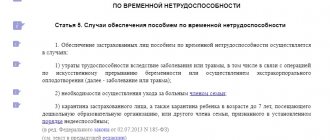In general, the right to annual, additional and other types of leave for a newly hired employee appears six months after employment (Part 2 of Article 122 of the Labor Code). This period means a continuous period of work in one organization. Although, to be precise, the Labor Code of the Russian Federation does not prohibit the provision of vacation in the first year of work and until the end of this period. This depends solely on the decision of the manager, the availability of free employees and the production situation.
Also, a new employee has the right to take one day off at any time before the end of the six-month period. This day will be calculated from the future vacation and paid at the same time. As for the probationary period, its duration may not be included in the required six-month period. This fact is reflected in the employment contract, which is why it is required to read it carefully before signing.
Article 122 of the Labor Code of the Russian Federation. Procedure for granting annual paid leave
New edition of Art. 122 Labor Code of the Russian Federation
Paid leave must be provided to the employee annually.
The right to use vacation for the first year of work arises for the employee after six months of continuous work with this employer. By agreement of the parties, paid leave may be granted to the employee before the expiration of six months.
Before the expiration of six months of continuous work, paid leave at the request of the employee must be granted:
for women - before maternity leave or immediately after it;
employees under eighteen years of age;
employees who have adopted a child (children) under the age of three months;
in other cases provided for by federal laws.
Leave for the second and subsequent years of work can be granted at any time of the working year in accordance with the order of provision of annual paid leave established by a given employer.
Decor
How will management and HR determine when vacation is due at a new job if the employee is not included in the approved schedule? Organizations approve it in December, 2 weeks before the new calendar year. And newly employed citizens do not always end up there. In this case, changes to the schedule are made after the fact, but not in all cases. A new employee who wants to go on vacation writes a statement indicating the date of departure and the duration of the desired vacation period.
Legal documents
- Article 115 of the Labor Code of the Russian Federation
- Article 122 of the Labor Code of the Russian Federation
- Labor Code of the Russian Federation
- Article 260 of the Labor Code of the Russian Federation
- Article 123 of the Labor Code of the Russian Federation
- Article 262.1 of the Labor Code of the Russian Federation
- Article 138 of the Labor Code of the Russian Federation
Commentary on Article 122 of the Labor Code of the Russian Federation
The right to use vacation for the first year of work arises for the employee after 6 months of his continuous work in this organization. By agreement of the parties, paid leave can be provided to the employee before the expiration of 6 months (Article 122 of the Labor Code of the Russian Federation).
Before the expiration of 6 months of continuous work, paid leave at the request of the employee must be provided (Article 122 of the Labor Code of the Russian Federation):
1) for women - before maternity leave or immediately after it;
2) employees under the age of 18;
3) employees who adopted a child under three months of age;
4) in other cases provided for by federal laws.
Leave for employees is granted for 28 calendar days. However, the vacation period does not include holidays.
When determining the duration of vacation, the organization's working hours (6-day or 5-day working week) do not matter.
This is the minimum duration guaranteed by law at the federal level. Therefore, annual basic leave cannot be less than 28 calendar days. However, it may exceed the specified number of days. This is done in two ways: regulatory and contractual. We are talking about extended basic leave provided to certain categories of workers in accordance with Part 2 of Article 115 of the Labor Code of the Russian Federation and other federal laws.
Procedure for extending vacations
As established by the standards enshrined in Article 124 of the Labor Code of the Russian Federation, annual paid leave is extended or moved to another period of time, calculated by the employer taking into account the wishes put forward by the employee in situations such as:
Procedure for extending leave
- Unforeseen occurrence of temporary disability in an employee
- Fulfillment by an employee of various types of government duties during the vacation period, if the legislation provides for the possibility of temporary release of such an employee from carrying out labor activities
- In other situations stipulated by the relevant standards of labor legislation and other legal acts of a local nature
In all of the above circumstances, the vacation period is automatically extended by the required number of days, while the employee is directly responsible for immediately notifying his employer of any unforeseen circumstances that have arisen.
The employee can do this by notifying his employer about the situation by telephone or telegraph, or by sending him the appropriate supporting documentation by fax or by registered mail.
When extending a paid vacation, a recalculation of the vacation funds transferred to the employee is not made, due to the fact that payment is made for a specific vacation period, and for the period when the employee was sick, he is paid a corresponding benefit from funds available to the Social Insurance Fund.
It should also be noted that, as provided for in Art. 120 of the Labor Code, according to the standards, non-working holidays (falling within the vacation period) are not included in the amount of calendar days constituting vacation and, of course, are not subject to payment. It quite naturally follows from this that in appropriate situations, the vacation entitlement to an employee may be increased by the number of non-working holidays falling during the period when this vacation is taken by the employee.
The provision of annual vacations requiring compulsory payment is strictly regulated by relevant legislative standards. Understanding the fundamental principles of this procedure and the correct use of its application allows you to effectively ensure strict compliance with relevant labor rights and avoid some possible misunderstandings.
Top
Write your question in the form below
Another comment on Art. 122 Labor Code of the Russian Federation
1. Paid leave must be provided to the employee annually, i.e. for each working year. On the concept of a working year, see paragraph 6 of the commentary to Art. 114 Labor Code of the Russian Federation.
2. Establishing that the right to leave for the first year of work arises for an employee after six months of his continuous work with a given employer, Art. 122 of the Labor Code of the Russian Federation simultaneously contains a list of cases when the next leave at the request of an employee must be granted before the expiration of this period.
Other cases provided for by federal laws when an employer is obliged to provide leave before the expiration of a six-month period of continuous work include: granting a husband, at his request, annual leave while his wife is on maternity leave, regardless of the time of his continuous work for this employer (see Part 4 of Article 123 of the Labor Code of the Russian Federation and commentary thereto); providing a person working part-time with paid leave simultaneously with leave from the main job if the employee has not worked for six months at part-time work (see Part 1 of Article 286 of the Labor Code of the Russian Federation and the commentary thereto).
Before the expiration of the six-month period, leave may be granted to the employee even in the absence of the specified grounds, if an agreement is reached on this by the parties to the employment contract.
3. The duration of leave granted before the end of the working year must be equal to the full duration of annual leave. Accordingly, the average salary is paid for the entire period of leave granted to the employee.
If an employee is dismissed before the end of the working year for which he received annual paid leave, a deduction is made from the employee’s salary to pay off his debt for unworked vacation days. Deductions for these days are not made if the employee is dismissed for the following reasons:
due to the employee’s refusal to transfer to another job required by him in accordance with a medical report, or the employer’s lack of appropriate work;
in connection with the liquidation of an organization or termination of activities by an individual entrepreneur;
due to a reduction in the number or staff of an organization or individual entrepreneur;
if the head of the organization, his deputy or chief accountant resign due to a change in the owner of the organization’s property;
Denial of leave to a new employee
Can a boss refuse leave? Maybe, if there are special circumstances. This requires the consent of the frame itself. A special order is issued and presented to the citizen for signature.
REFERENCE: In other cases, the vacation schedule is unshakable for both parties to the employment contract. If the employer persists, the person can, firstly, not go to work from the day prescribed by the schedule (and this will not be absenteeism!), and secondly, complain about the satrap to the labor inspectorate or the prosecutor's office. Or there and there at the same time.
Read on to learn what to do if your employer does not allow you to go on vacation according to the vacation schedule.
An inspection will follow and if it turns out that the organization is to blame, then this will result in a fine of up to 50 thousand rubles (Article 5.27 of the Administrative Code). It is very important to read the contract carefully when applying.
It may well contain a special order, and the signature will mean that you have accepted all the conditions. If the schedule is approved, neither the boss nor the employee needs to violate it.
Vacation in the first year. Vacation for the second year. Vacation for subsequent years.
The right to vacation in the first working year arises for an employee only after six months of continuous work with the employer. By agreement of the parties, paid leave may be granted to the employee before the expiration of six months. the right of every employer.
There is also an obligation to provide paid leave before the end of six months of continuous work:
- for women - before maternity leave or immediately after it;
— workers under the age of 18;
- employees who have adopted a child (children) under the age of three months and in other cases provided for by federal laws.
In all of the above cases, the basis for granting leave for the first working year is a written application from the employee.
Vacation for the second year and subsequent years of work can be provided at any time of the working year in accordance with the order of provision of annual paid vacations established in your organization. In this case, in one calendar year, an employee can be granted two vacations for different working years. This means that annual paid leave is granted for each working year (12 months). And the six-month period is just the period when the employee becomes entitled to use his first vacation. This does not mean that he must be given leave every 6 months of work. He is entitled to only one vacation per working year.
Therefore, if an employee received vacation for the 1st year of work after 6 months, he must work for the employer for another 5 months (6 months + 1 month of vacation + 5 months = 12 months), and only then is he entitled to vacation for next (second) working year. In this case, the employer can provide such an employee with leave for the second year of work either at the very beginning of the second year or at the very end.
The first working year is calculated from the date of entry into work in this organization, and subsequent ones from the day following the end of the previous working year.
The duration of continuous work gives the employee the right to receive leave. The Labor Code calls the duration of such work “work experience, giving the right to annual basic paid leave” (Article 121 of the Labor Code). The length of service that gives the right to annual basic paid leave is included.
— time of actual work;
- the time when the employee did not actually work, but in accordance with federal laws he retained his place of work (position), including the time of annual paid leave;
— time of forced absence due to illegal dismissal or suspension from previous work;
- other periods of time provided for by the collective agreement, employment contract or internal (local) regulatory act of the organization.
The length of service giving the right to annual basic paid leave is not included.
1. the time an employee is absent from work without good reason, including due to his removal from work in cases where:
- he showed up to work in a state of alcohol, drug or toxic intoxication;
— did not undergo training and testing of knowledge and skills in the field of labor protection in the prescribed manner;
- did not undergo mandatory preliminary or periodic medical examination in accordance with the established procedure;
- has, in accordance with a medical report, contraindications for performing his work stipulated by the employment contract;
- suspended at the request of bodies and officials authorized by federal laws and other regulatory legal acts;
— in other cases provided for by federal laws and other regulatory legal acts.
2. Time of leave to care for a child until he reaches the legal age.
3. The time of unpaid leave granted at the request of the employee for a duration of more than seven calendar days.
Experience giving the employee the right to annual paid leave . begins to be calculated from the day he begins working for a specific employer.
- Are you here:
- home
- Vacation
- Vacation in the first year. Vacation for the second year. Vacation for subsequent years.
See also Rules on regular and additional leaves, approved by the People's Commissariat of Labor of the USSR on April 30, 1930 N 169
Upon written request from the employee, unused vacations may be granted to him with subsequent dismissal (except for cases of dismissal for guilty actions). In this case, the day of dismissal is considered the last day of vacation.
Duration
Art. 115 of the Labor Code establishes a specific number of vacation calendar days (excluding holidays) per year; this number cannot be lower than 28 . Providing leave in the first year of work with it being cut in half or otherwise, with the remainder being issued later, is possible only with the consent of the employee (Article 125 of the Labor Code). This rule does not apply to additional leave provided in industries with working conditions characterized by increased danger and harm to health. The duration of this depends on the amount of time actually worked (Article 121 of the Labor Code) and is usually 10 days per year.
note
An employee can resign both after the vacation and during it. According to the law, vacation days count towards the number of hours worked - it is only important to submit your resignation on time. Read more in this article
If the employee is dismissed before the end of the working year, his salary can be reduced by the amount of vacation pay received for all days on which work was not performed (Article 137 of the Labor Code, paragraph 2 of Rules No. 169 of the NKT of the USSR of April 30, 1930 ). Here you need to take into account that the total amount of all deductions should not exceed 20% of earnings (Article 138 of the Labor Code). This is the reason for the impossibility of fully collecting debt from an employee in some cases.
Article 122 of the Labor Code of the Russian Federation. Procedure for granting annual paid leave
Paid leave must be provided to the employee annually.
The right to use vacation for the first year of work arises for the employee after six months of continuous work with this employer. By agreement of the parties, paid leave may be granted to the employee before the expiration of six months.
Before the expiration of six months of continuous work, paid leave at the request of the employee must be granted:
for women - before maternity leave or immediately after it;
employees under eighteen years of age;
employees who have adopted a child (children) under the age of three months;
in other cases provided for by federal laws.
Leave for the second and subsequent years of work can be granted at any time of the working year in accordance with the order of provision of annual paid leave established by a given employer.
Features of filling out the vacation schedule
According to the Labor Code of the Russian Federation, the sequence of annual paid vacations is established according to the schedule. It is left two weeks before the end of the current working year. This is enshrined in Article 123 of the Code.
If, at the time of drawing up the schedule, the organization has employees who have been working in the company for less than six months, it must be included in the schedule for the next year.
If an employee’s circumstances change and he gains the right to receive paid days off earlier, the manager is obliged to make appropriate adjustments to the vacation schedule.
Comments to Art. 122 Labor Code of the Russian Federation
1. Paid leave is provided annually, according to the established vacation schedule, which is drawn up for each calendar year and approved no later than 2 weeks before the start of the calendar year.
2. When drawing up a vacation schedule, the employer takes into account the employee’s opinion, if this does not disrupt the organization’s production cycle.
3. When calculating the length of service for which an employee is granted annual paid leave, the main unit of account is the month.
4. Paid leave is provided once per working year in accordance with the schedule. The working year is 12 full calendar months from the date the employee joins the organization on the basis of an employment contract.
5. The number of days of work is less than 1 month. is taken into account only when providing additional paid leave in proportion to the time worked and payment of compensation for unused leave upon dismissal. In these cases, the number of days is less than 1/2 month. is excluded from the calculation, and half or more is rounded up to the nearest month.
6. Leave for the first year of work is provided to employees, as a rule, after 6 months. continuous work in the organization, except for the cases specified in the commented article and in other regulations, when leave is granted before the expiration of this period.
For the second and subsequent years of work, vacations are granted at any time of the year, except for the cases specified in the commented article, taking into account the vacation schedule and the employee’s wishes, if this does not disrupt the normal functioning of the organization.
7. The vacation schedule is a local normative act, which is drawn up by the employer taking into account the opinion of the elected body of the primary trade union organization no later than 2 weeks before the start of the calendar year.
8. Leave should not, as a rule, begin earlier than the working year for which it is granted. In addition, when drawing up a vacation schedule, it is necessary to comply with the provisions of the commented article, since for some categories of employees the right to use vacation before the expiration of 6 months is established as a benefit. continuous operation.
Schedule
As Art. 123 of the Labor Code, a document defining the procedure for employees to go on vacation in the next calendar year, is drawn up in December of the current year before the 17th. Therefore, persons hired after the schedule was approved and who have worked for the required 6 months have the right to request rest in any of the remaining periods of the working year. Its countdown begins from the month of employment in this organization.
If an employee wants to go on vacation in a month falling in the next calendar year, this is simply recorded in the new schedule. Otherwise, he needs to submit an application addressed to the director. Alternatively, you can draw up an additional vacation schedule, agreed upon with other employees or the chairman of the trade union. The employee is notified of the date of retirement no later than 14 days before it occurs.
How to prevent troubles?
Despite the fact that the labor inspectorate and the court more often take the employee’s side, such proceedings require a waste of time and nerves. To avoid this, it is worth knowing how to prevent troubles associated with granting leave.
There is one important rule - every person must pay attention to the contents of the employment agreement before signing it. The reason is that such a contract may provide for a special system for providing days of rest.
All papers that are handed over to an employee for signature must be read first. Otherwise, there is always a risk of encountering unexpected and unpleasant factors, and sometimes even being denied leave at the desired time.











